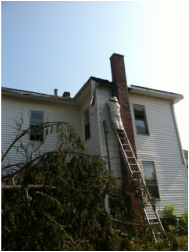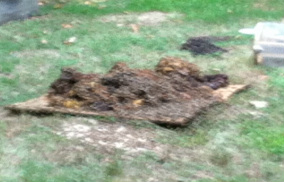
Michael extracting the hive
What happens when a giant tree meets a hive bees? Michael Duncan.
Most of you reading this post, I'm sure, were one of the 600,000 left without power for days after a violent storm ripped through Ohio at the end of June. Line men from as far as Alabama reported to work with urgency, adopting a modifed U.S Postal Service creed as their own-- neither dangling branches, nor 4th of July festivities, nor extreme heat of day would keep these electricians from the swift completion of their appointed rounds. Nothing could stop them from getting the power back on. Nothing that is...except for a hive of honeybees.
This proved to be the case for a man in Pataskala who had a large tree fall on his house and sever his power connection. The power company arrived to reestablish the connection only to discover access to the power lines restricted by a hive of honeybees living in the wall of the house. Power couldn't be restored until the bees were removed. Quite a sticky wicket, literally. Exit power company, stage left. Cue Michael Duncan.
Michael Duncan is a delightful contradiction. A gentle and altruistic man of many interests, Michael is a firefighter/paramedic, Eagle scout dad, devoted family guy, a fly-fisherman and a passionate, DYI beekeeper who is allergic to bees. That's right. He's allergic to bees. But it takes more than a nasty allergy and the fact he should have an EpiPen perscription to keep Michael from extracting bees and from some rather interesting places. Each year Michael gets a multitude of calls asking him to remove (or from a beekeeper's view "retrieve") swarms and hives from the walls of homes, from under cars, from the backs of mini-vans and even from trees for sale in the Home Depot parking lot on 21st Street. But in his 12 years of beekeeping, Michael had never had an experience quite like this.
On inspecting the hive in Pataskala, Michael had a stunning revelation. He would be extracting a decades old hive that was EIGHT FEET tall and wedged between the interiors of the wall. Over the course of two days and in 100 degree heat, Michael voluntarily suited up in full beekeeping gear (long sleeves, jeans, bee suit, gloves, and veil) and while perched precariously on a ladder two stories high extracted the hive using a Bee-Vac vaccum, a modified commerical shop vac that sucks up bees and deposits them into a 5-gallon screened bucket. (Find pics of the Bee-Vac in my photo gallery). Like an inverted summer Santa, Michael spent hours coming up and down from the rooftop, dressed all in white, dragging behind him garbage bags full of honeycomb. Not only was he often overcome by the heat, he was repeatedly stung through his gear, causing one of his eyes to swell shut overnight.
Most of you reading this post, I'm sure, were one of the 600,000 left without power for days after a violent storm ripped through Ohio at the end of June. Line men from as far as Alabama reported to work with urgency, adopting a modifed U.S Postal Service creed as their own-- neither dangling branches, nor 4th of July festivities, nor extreme heat of day would keep these electricians from the swift completion of their appointed rounds. Nothing could stop them from getting the power back on. Nothing that is...except for a hive of honeybees.
This proved to be the case for a man in Pataskala who had a large tree fall on his house and sever his power connection. The power company arrived to reestablish the connection only to discover access to the power lines restricted by a hive of honeybees living in the wall of the house. Power couldn't be restored until the bees were removed. Quite a sticky wicket, literally. Exit power company, stage left. Cue Michael Duncan.
Michael Duncan is a delightful contradiction. A gentle and altruistic man of many interests, Michael is a firefighter/paramedic, Eagle scout dad, devoted family guy, a fly-fisherman and a passionate, DYI beekeeper who is allergic to bees. That's right. He's allergic to bees. But it takes more than a nasty allergy and the fact he should have an EpiPen perscription to keep Michael from extracting bees and from some rather interesting places. Each year Michael gets a multitude of calls asking him to remove (or from a beekeeper's view "retrieve") swarms and hives from the walls of homes, from under cars, from the backs of mini-vans and even from trees for sale in the Home Depot parking lot on 21st Street. But in his 12 years of beekeeping, Michael had never had an experience quite like this.
On inspecting the hive in Pataskala, Michael had a stunning revelation. He would be extracting a decades old hive that was EIGHT FEET tall and wedged between the interiors of the wall. Over the course of two days and in 100 degree heat, Michael voluntarily suited up in full beekeeping gear (long sleeves, jeans, bee suit, gloves, and veil) and while perched precariously on a ladder two stories high extracted the hive using a Bee-Vac vaccum, a modified commerical shop vac that sucks up bees and deposits them into a 5-gallon screened bucket. (Find pics of the Bee-Vac in my photo gallery). Like an inverted summer Santa, Michael spent hours coming up and down from the rooftop, dressed all in white, dragging behind him garbage bags full of honeycomb. Not only was he often overcome by the heat, he was repeatedly stung through his gear, causing one of his eyes to swell shut overnight.

Bees feasting on 80 pounds of honeycomb
Sadly, since Michael had no option but to draw out the honeycomb simutaneously with the bees, the Pataskala hive did not survive. Why? **Bee Lesson #1** Bees need to be dry. As the Pataskala bees were pulled through the vaccum tubing they bumped against the honey. The honey adhered to the bees, weighing them down, so as the bees filled-up the bucket en mass, they couldn't move and suffocated. But there is a happy ending! Michael took home EIGHTY pounds of honeycomb. For the next three days, his five hives emptied the comb of its honey and transported it back to their own hives. And what will happen to 80 pounds of empty comb? Racoons.
And Michael Duncan? No worries. He'll bee back again!
And Michael Duncan? No worries. He'll bee back again!
 RSS Feed
RSS Feed